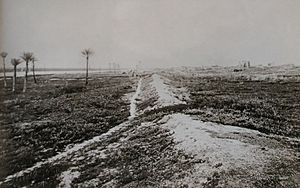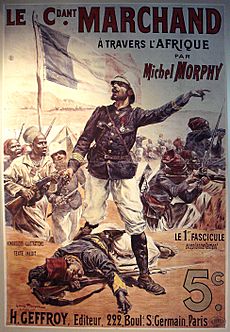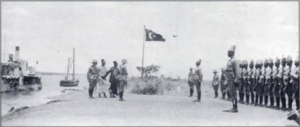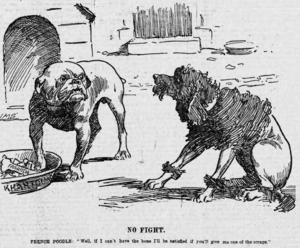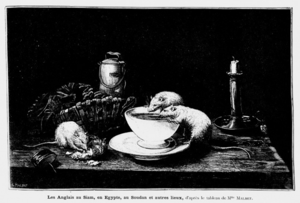Fashoda Incident facts for kids
Quick facts for kids Fashoda Incident |
|||||||
|---|---|---|---|---|---|---|---|
| Part of the Scramble for Africa | |||||||
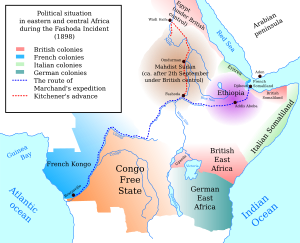 Map of Central and East Africa during the incident |
|||||||
|
|||||||
| Belligerents | |||||||
|
|
|||||||
| Commanders and leaders | |||||||
| Strength | |||||||
| 132 soldiers | 1,500 British, Egyptian and Sudanese soldiers | ||||||
| Casualties and losses | |||||||
| None | None | ||||||
The Fashoda Incident was a big disagreement between Britain and France in 1898. It happened in East Africa during a time called the Scramble for Africa. This was when European countries were trying to claim as much land as possible in Africa.
A French team went to Fashoda on the White Nile river. They wanted to control the Nile river area. This would stop Britain from taking over Sudan. The French group met a British-Egyptian army there. The British army was much bigger.
The two groups met in a friendly way. But back in Europe, people thought a war might start. Both countries were very angry. France finally decided to leave Fashoda. This meant Britain and Egypt kept control of the area.
Contents
Why Fashoda Was Important
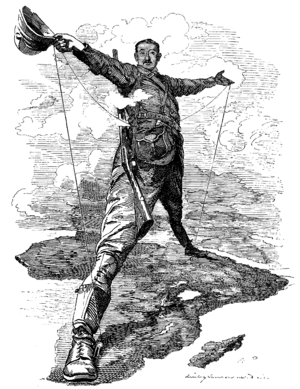
In the late 1800s, European countries were taking over many parts of Africa. This period is known as the Scramble for Africa. After a meeting in Berlin in 1885, countries rushed to claim any land left. The main countries involved were Britain, France, Germany, Belgium, Italy, Portugal, and Spain.
France wanted to connect its lands from the Atlantic Ocean coast (like modern-day Senegal) all the way to the Red Sea. This would create a French belt across Africa. Their goal was to control trade routes across the Sahel region. They already controlled trade routes through the Sahara desert.
Britain had a different plan. They wanted to link their lands in Southern Africa (like South Africa) with their lands in East Africa (like modern-day Kenya). They also wanted to connect these areas to the Nile river basin. Sudan was key to this plan. Egypt was already under British control. This idea was called the 'Cape to Cairo' plan. It was made famous by a British politician named Cecil Rhodes. He wanted Africa to be "painted Red," meaning under British control.
If you draw a line from Cape Town to Cairo (Britain's dream) and another from Dakar to Djibouti (France's dream), they cross near Fashoda. This is why Fashoda was so important. The country that controlled this spot could continue its plan.
Fashoda was started by the Egyptian army in 1855. It was a base to fight the slave trade. It was a good spot on high ground where boats could unload. The area was swampy but had people living there. By the 1870s, Fashoda was a busy market town. European explorers visited it. When the French arrived, the old fort was in ruins.
Britain and France also argued a lot about who should control Egypt. Many French politicians wished France had helped Britain take over Egypt in 1882. They hoped to make Britain leave Egypt. They thought a French base on the Upper Nile could help them do this. Some even thought about building a huge dam to cut off the Nile's water. These ideas worried British officials.
Other European countries also wanted the Upper Nile. Italy tried from its base in Eritrea. But they lost a big battle in Ethiopia in 1896. King Leopold II of Belgium also sent troops towards the White Nile. But his soldiers rebelled in 1897, and the plan failed.
The Crisis Begins
Marchand's Journey
France decided to act first. They sent Captain Jean-Baptiste Marchand to Africa. He was a brave soldier who had fought in French Sudan. In June 1896, he arrived in Gabon with a small group. He had only 120 African soldiers and 12 French officers and staff.
Marchand's team left Brazzaville with orders to take control of Fashoda. They wanted to make it a French protectorate. They traveled up the Ubangi River by boat. Then they marched overland through jungles and deserts to Sudan. They carried 100 tons of supplies, including a boat they could take apart.
They hoped to meet other French teams coming from the east. But these other teams did not make it. Marchand's small group was all alone. After a very hard 14-month journey, they reached Fashoda on July 10, 1898.
Meanwhile, the British were taking over Sudan from Egypt. They were moving up the Nile river. On September 18, five British gunboats arrived at Fashoda. They carried 1,500 British, Egyptian, and Sudanese soldiers. Their leader was Sir Herbert Kitchener. Marchand had thought the approaching force was enemies. But now he faced a diplomatic problem, not a battle.
The Standoff at Fashoda
Both sides believed Fashoda belonged to them. But they agreed to wait for orders from their home countries. The two commanders were polite to each other. Kitchener even joked about a French garden, saying, "Flowers at Fashoda. Oh these Frenchmen!" The British also gave the French newspapers. These papers showed that France was having political problems at home. This suggested France could not really help Marchand.
News of the meeting reached Paris and London. It made people in both countries very angry. Everyone accused the other side of being too aggressive. The crisis lasted through September and October 1898. The British navy even prepared for war.
France Steps Back
Kitchener had just defeated the forces of the Mahdi in Sudan. He was taking back Sudan for Egypt. After his victory, he went to Fashoda. He wore an Egyptian army uniform. He insisted on raising the Egyptian flag near the French flag.
Britain had a much stronger navy than France. French politicians knew this. The French foreign minister, Théophile Delcassé, said, "They have soldiers. We only have arguments." He did not want a war with Britain. He wanted Britain's friendship, especially if France had to fight Germany later. So, he pushed for a peaceful end to the crisis.
Even though many French people were angry at Britain, the government decided to withdraw. A French writer said, "Germany keeps slapping us in the face. Let's not offer our cheek to England." This meant France should not fight Britain when it had other problems. The British insisted that France leave Fashoda right away. France had to agree, which was a public embarrassment for them.
What Happened Next
Many French nationalists felt that France's surrender showed their army was weak. But a big political scandal in France, called the Dreyfus affair, distracted people. They started to wonder if fighting over a faraway part of Africa was worth it. So, on November 3, the French government quietly told its soldiers to leave. The crisis ended peacefully. Marchand chose to leave through Ethiopia and Djibouti, not through Egypt.
The Fashoda Incident was a win for Britain. France realized they needed Britain's friendship. This was important in case of a future war with Germany.
In March 1899, Britain and France signed an agreement. They decided that the source of the Nile and Congo rivers would be the border between their areas of control.
The Fashoda Incident was the last big argument between Britain and France over colonies. Many historians believe it helped them become friends later. This friendship led to the Entente Cordiale in 1904. A bridge in France is named after Kitchener and Marchand. In 1904, Fashoda was renamed Kodok. It is now in modern-day South Sudan.
Lasting Impact
The Fashoda Incident led to something called the 'Fashoda syndrome' in French foreign policy. This means France would try to show its power in areas where Britain might gain influence. This idea was used to describe other events later on.
See also
- Anglo-Egyptian conquest of Sudan
- How big countries got along (1814–1919)
- France–United Kingdom relations
- Pink Map


